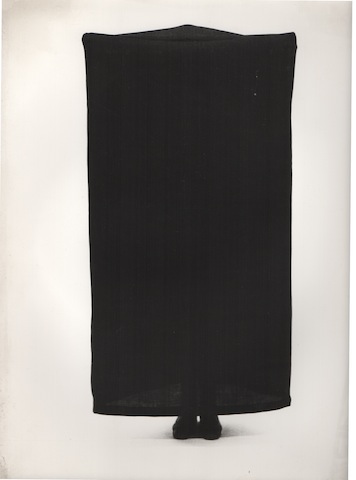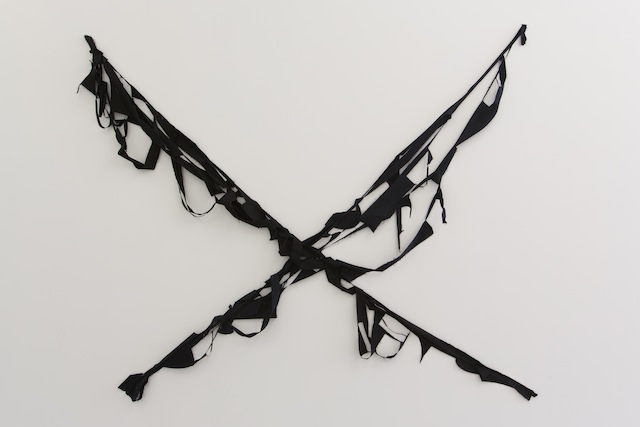In the sunny nook of a glass-and-steel modernist villa outside Milan that serves as her modest live-in studio, while a fox-faced blonde dog called Gipsy prowls around, Marion Baruch is describing a revelatory encounter with a sack of discarded fabric. She got it from a man she met in a pizzeria who worked in the Italian fashion industry (for Gucci et al), and it contained the negative space of style: unwanted cloth left over once the shapes for haute couture and high-end prêt-à- porter had been cut out. She recalls the moment when she pulled out the first remnant and held it up: “I said, ‘My God, what is this? It’s what you throw in the bin, and it looks like a Klee.’”
Or, if you prefer, like a Baruch – like, say, Sculpture (Spirito della Giungla) (2015), one of several works by her recently on show in Rome’s National Gallery of Modern and Contemporary Art. This relief structure of stirruplike black loops – after she selects her garment discards, it’s all about how she pins and painstakingly drapes them, collaborating with gravity – is both tattered and graceful, and demonstrates her format’s versatility. Sculpture… is in formal conversation with the modernist past (Robert Morris, Eva Hesse, Lucio Fontana, Supports/ Surfaces artist Daniel Dezeuze), yet its attitude to the exclusivity of fashion – the way in which it creates aleatory richness from what the industry disdains – feels lithely ironical and fresh. The work suggests a young artist, schooled in art history, gazing askance at capitalism’s relentless rhythms. Marion Baruch is eighty-seven. When, in 1950, she left her native Romania to go to art school in Israel, her tutor there had studied under Klee.
A multilingual cosmopolite with a dry wit and ascetic tastes, Baruch is increasingly being shown by adventurous young European gallerists alert to the correspondence between her slackly elegant works and those of post-postminimalist artists five decades or more her junior. But she isn’t the type of journeywoman figure, like Carmen Herrera, being feted late in life for something she’s done for decades. Baruch began working in this way – a lightweight, adaptable, self-replenishing format as suited to her age as Henri Matisse’s cut-outs were to his – in 2012, shortly after returning to Italy after 14 years in Paris. “I ran out of money,” she says cheerfully, this condition being perhaps not unconnected to the fact that from the early 1990s, when she was in her early sixties, onwards she was an exponent of relational aesthetics, itself an updated version of the Beuys-inspired social art of which Baruch has been a longstanding practitioner.
The work suggests a young artist, schooled in art history, gazing askance at capitalism’s relentless rhythms.
The immediate roots, though, of gorgeously casual recent works such as her Echo de mer et de soleil (2016) – another black remnant, full of swooping, loosely birdlike apertures – are in those relational projects, made under the pseudonym Name Diffusion. This legally incorporated company created sardonic ‘products’ for exhibition, eg Museum Fashion (1993), a rack of orange pure-silk shirts for the Netherlands’ Groninger Museum, patterned with a logo alternating Baruch’s trading name and the institution’s. In later works such as 2008’s Trame di Penelope, her artful pseudo-business presented tumbling installations of scrap cloth, encouraged viewers to recline in its spaces, and used them as sites for philosophical conferences, because, says Baruch, “people think and talk so differently when they’re lying down”. One ought to mention here that her late husband and her children were and are, respectively, involved in Italian textile manufacturing. She, however, appears perpetually interested in fashion’s other side, the improvisatory obverse of its psychic controls.

“It’s the void, and there’s possibility in the void: it contains everything, it contains surprise, life and emotion, which is what I need”
As early as 1970, Baruch had made Abito-Contenitore, a tombstone-shaped dress, covering head and body like a burka, in which she performed a happening of sorts, strolling down Milan’s main fashion street, Via Monte Napoleone. (For that, she ended up on the cover of one of Italy’s best-known weeklies, Panorama.) Around the same time she decided to have a huge Plexiglas ball manufactured, put a young man in it and roll it down the street, stopping traffic. This led to an association with Dino Gavina, the Italian furniture producer (and friend of Marcel Duchamp and Man Ray) who first mass-marketed Bauhaus furniture. Gavina helped Baruch realise a few rogue furniture pieces, such as Ron Ron (1971), a furry spherical footstool with a tail; and though she sees them as art, such works are now being shown again in design circles, for instance at the Milan Triennale last year. Such is the pattern of her career, which moves in surprising circles but also consistently forward. Like fashion, then – and the things she makes now keep her, she says, connected with that world and the larger one it’s nested in. Textiles, she says, are “living material for me, and I feel the flow of it, a continuous flow, which is the whole society. And also fashion is all about new materials, new forms…” Indeed, Baruch has almost always self-aligned with the new, however idiosyncratically. She was born in 1929 in Timisoara, but when she got a rare chance to go and study in Jerusalem – “at art school in Romania, we just had to paint Stalin” – she took it. Then, on the back of a successful show in Tel Aviv, in the mid-1950s she went to Rome, an odd fit for her outlook. “A big mistake. I was overwhelmed by the beauty of the city, Giotto, etc, and I didn’t learn anything.” For the next couple of decades she lived in Italy and in France, where she made “big sculptures in iron”, and then popped up in, of all places, Milton Keynes, circa 1980 (a new town, pointedly). From here, visiting London’s museums, she’d paint miniature copies of works by Rembrandt overlaid with Duchamp’s maxim-on-the-Mona-Lisa, ‘L.H.O.O.Q.’, the French pun ‘she has a hot ass’. “I was the one with the hot ass, sitting on my seat, painting the big master,” Baruch recalls. She took them to Nicholas Logsdail at London’s Lisson Gallery. “He said, ‘It’s interesting, but it’s not interesting to me’.”
From an outside perspective, it appears she had to reconnect with the garment business – the locus of her linkage of art and life – as she did when she ‘became’ Name Diffusion, for her work to get into gear. Now that it has, her latest style is already evolving. (Which is typical for Baruch.) At first she selected discards that were rectangular like a painting, the computer-cut shapes offering a Rorschach-like experience of flitting, fragmentary allusion; later, she began bunching them together in treelike formations. Nowadays she’s increasingly drawn to fragments, and this has analogical force for her. “It’s the void, and there’s possibility in the void: it contains everything, it contains surprise, life and emotion, which is what I need.”

A work like Pleine détente (2016) bears this out: it’s a sky-blue offcut, a horizontal strip from which dangle a few skimpy fabric lines that nevertheless create sophisticated polyhedral areas of negative space. As if staring at clouds, you see little glimmers of things in it, made by the white wall: the curving edges of screens, for example. (Her forthcoming solo show in Paris, Baruch says, will include a piece called Cloud, referring to clouds both natural and digital.) ‘Full relaxation’, the translation of the work’s title, seems an apropos sentiment – the unknown, seen this way, is something one eases into, something welcoming. And yet, as she points out, her elective negative space contains ‘everything’, for better or worse. A work from 2015, Mister Horror (L’Éternel Retour), features two crossed, ragged black fragments, like overlapping rifles or knives; no coincidence that it was made after the terror attacks on Paris that year.
Due to mobility issues, Baruch mostly stays in her workspace, with its sunlight-streaming floor-to-ceiling glass, its teetering stacks of archive boxes, works-in-progress pinned to all walls, pulling fabric from bags and seeing what chance has handed her. Downstairs, her archive is being photographed. She gestures around. “Here I’m closed off and I can’t circulate. But I’m not alone, you see. On summer nights this big moon comes right through the windows and I’m here at 3am, the whole world comes in to me through these materials, and I work with these voids, which for years have been becoming bigger and bigger. You know, at first I was afraid to insist on the void. But now,” she smiles, “I’m not afraid any more.” And with that, she rises; time to get back to work.
Marion Baruch’s solo exhibition Le parti pris des nuages is on show at Galerie Anne-Sarah Bénichou, Paris, through 13 July.
From the May 2017 issue of ArtReview
